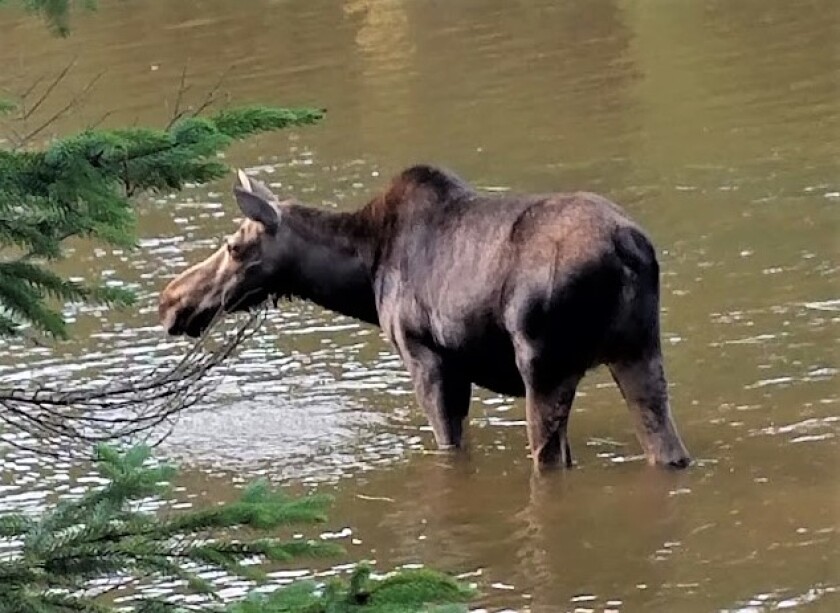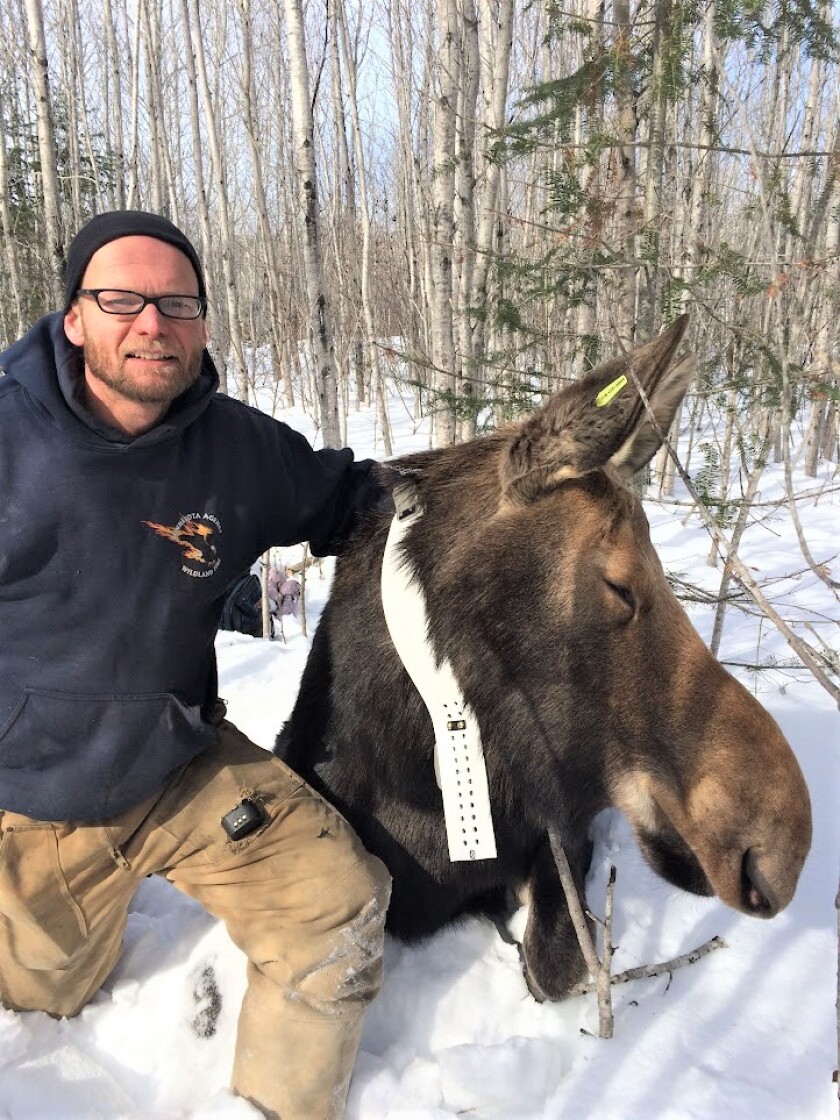GRAND PORTAGE — Scientists have known for decades that Minnesota moose are dying from a brainworm called P. tenuis, but they were never quite sure how the moose acquired the parasite.
Now they know a little more.
The brainworm, which is moved around the forest by white-tailed deer but is harmless to deer, must pass through a snail or slug before it gets to the moose, and scientists with the Grand Portage Band of Lake Superior Chippewa and the University of Minnesota have confirmed some of snails are to blame and how the moose are picking them up.
Their findings were published in the recent edition of the Journal of Wildlife Diseases.
Brainworm isn't the only reason Minnesota’s moose population crashed over the past 30 years, but they are one of the biggest reasons. Seth Moore, director of environment for the Grand Portage Band, said brainworm is killing up to 30% of the adult moose he’s been studying for the past 18 years at the tip of Minnesota's Arrowhead region. It may be killing even more moose in areas where more deer exist.
ADVERTISEMENT

Contributed / Seth Moore / Grand Portage Band
Because scientists now know which snails — gastropods — are to blame, they are looking at ways to manage the forest to reduce the number of those snails and perhaps reduce the volume of P. tenuis on the landscape.
“If we know the gastropod species that moose are consuming, and those also are known to carry brainworm, there are forest-cutting practices and prescribed burning approaches we can explore that reduce the abundance of those gastropods,” Moore said.

Contributed / Seth Moore / Grand Portage Band
Moore, along with Tyler Garwood and Tiffany Wolf, researchers from the College of Veterinary Medicine at the University of Minnesota, analyzed 258 samples of moose and deer feces collected on and around the Grand Portage reservation to check for snails. Then they used DNA analysis to determine which snails (and slugs) in the feces were carrying brainworm.
While eating slugs and snails has long been considered the mode by which moose become infected with brainworm, this is the first study to empirically document this interaction in the wild.
“There’s been a ton of research on the deer part of this (brainworm) cycle. But understanding the other pieces of the cycle, the slugs and snails, is helping explain how this is impacting moose,” Garwood said.
Crash and recovery?
Northwestern Minnesota had lost virtually all of its moose by the 1990s, with scientists determining that warmer temperatures helped spur multiple problems for moose, including more deer and more brainworm. They have never bounced back.
Then, in the 2000s, Northeastern Minnesota moose numbers crashed by nearly 70%, from a modern high of 8,840 moose estimated in the Arrowhead region in 2006 to just 2,700 by 2013.
ADVERTISEMENT
Since then the northeastern population has stabilized, but has shown no signs of any major rebound. Experts believe habitat is a critical issue, with moose requiring vast areas of burned or logged forest so they can munch on the new saplings and bushes that grow back. But parasites and predators are other key factors.

Contributed / Tyler Garwood / University of Minnesota
“If we are going to make sure we have moose on this landscape we need to take a multifaceted approach with habitat management, predator management and deer management, all in a focused area. But that will only happen if we believe that saving this species is a priority,” Moore said.
In addition to clearing more land to create better moose food, scientists say the combination of logging and fire can also reduce the number of slugs and snails on the landscape.
“There has already been research … that shows active management, timber cutting, reduces gastropods. And adding prescribed fire to that reduces them even more,” Moore said.
Biologists have known for a while that keeping deer numbers down near moose helps reduce P. tenuis. And while reducing deer deer numbers is likely the single best step to help moose, by reducing the amount of brainworm in the area, Garwood said reducing snails and slugs “would be another tool in our toolbox.”
Getting rid of all deer near moose would eventually solve the brainworm problem, but “probably isn’t feasible,” Garwood said. “It may be more politically acceptable to manage slugs and snails than managing deer to the level that you can reduce brainworm.”

Contributed / Katherine Marchetto / University of Minnesota
Moore also advocates a focused wolf and bear management effort to reduce predators and give moose calves a fighting chance to survive to adulthood, the first step in rebuilding the moose population.
“If we are losing 30% of our adults to brainworm, and losing virtually all of the calves to predators, there’s just not much chance this species can hang on in the long run,” Moore said, adding that it may be socially and politically difficult if not impossible to trap or hunt wolves in a focused area — even the effort is aimed at saving moose.
ADVERTISEMENT
What’s the deal with brainworm?
Warning: Don’t read this part of the story if you have a sensitive stomach. Brainworm has been living inside the brains of white-tailed deer for millennia, but they don’t affect the deer, their host, at all. Brainworm is present in up to 90% of all white-tailed deer in North America.
The worms lay their eggs in the deer’s brain. The eggs then pass through the deer’s circulatory system and get pooped out as larvae in deer feces. Snails relish a good poop meal and consume the deer feces that carry the brainworm larvae. Then moose accidentally eat the snails while browsing on brush and tree saplings.
“I’ve seen some hazelnut bushes just covered with snails after a rain,” Moore said. “The moose are picking them up higher up off the (brush) and not from the ground.”

Contributed / Seth Moore / Grand Portage Band
Unlike deer, native to the south, moose in the north never evolved with the brainworm. It’s only been since deer moved into northern Minnesota a century ago — after most of the state was clear-cut logged and burned — that deer brought brainworm far enough north to start killing moose. Eventually, as northern Minnesota’s deer population grew thanks to a trend of milder winters, the amount of brainworm on the landscape became dense enough to severely impact moose populations.
Moore said the brainworm larvae eventually works its way through the moose to the brain, but because the adults can’t find their right "habitat" (found only in deer brains) they begin tunneling around in the moose brain looking for it, Moore said. That tunneling is what ultimately kills the moose, rendering it helpless, unable to even walk in a straight line.
Moore said that a recent drop in Northeastern Minnesota’s deer population, thanks to a string of deep snow winters, has already led to an at least temporary decline in brainworm. That will probably change if the Arrowhead region gets a few mild winters and deer numbers bounce back as they did 20 years ago.
“We didn’t have any brainworm deaths (among moose) this past year,” Moore noted.
ADVERTISEMENT
Researchers say the effort is important not just to keep an iconic species on the Minnesota landscape, but also for the big animal’s significance to the Ojibwe people.

Contributed / Seth Moore / Grand Portage Band
“Because this work is done in partnership with the Grand Portage Band, for whom moose are an important subsistence species and source of cultural preservation, a primary motivation of our research is maintaining healthy moose populations on and near the Grand Portage Indian Reservation,” Garwood said. “More broadly, moose are an iconic species for our state and fill an important ecological niche as the largest herbivore in the northwoods ecosystem.”
Funding for the research was provided by the Minnesota Environment and Natural Resources Trust Fund; the state’s lottery profits; the National Institute of Food and Agriculture; the Van Sloun Foundation; the University of Minnesota Genomics Center; the federal Great Lakes Restoration Initiative; the Grand Portage Band of Lake Superior Chippewa; and private donations.
The Link LonkSeptember 01, 2023 at 06:00PM
https://news.google.com/rss/articles/CBMia2h0dHBzOi8vd3d3LmR1bHV0aG5ld3N0cmlidW5lLmNvbS9zcG9ydHMvbm9ydGhsYW5kLW91dGRvb3JzL21pbm5lc290YXMtbW9vc2UtbXlzdGVyeS11bnJhdmVscy1hLWxpdHRsZS1tb3Jl0gEA?oc=5
Minnesota's moose mystery unravels a little more - Duluth News Tribune
https://news.google.com/search?q=little&hl=en-US&gl=US&ceid=US:en

No comments:
Post a Comment